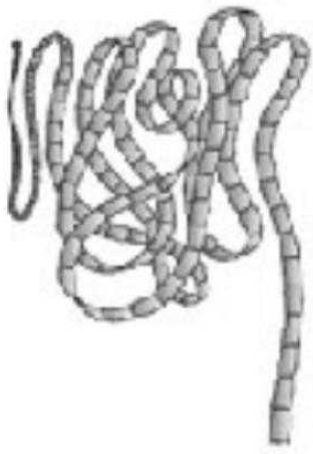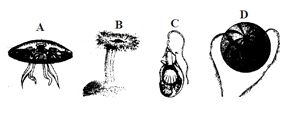Refer the figures A, B, C and D given below. Which of the following options shows the correct name of the animals shown by the figures A, B, C and D ?

A – Locust, B – Scorpion, C – Prawn, D – Pila
A – Locust, B – Prawn, C – Scorpion, D – Pila
A – Locust, B – Scorpion, C – Prawn, D – Snail
A – Butterfly, B – Scorpion, C – Prawn, D – Pila
Correct Answer :
A. A – Locust, B – Scorpion, C – Prawn, D – Pila
Locusts are the swarming phase of certain species of shorthorned grasshoppers in the family Acrididae. Scorpions are predatory arthropod animals having eight legs and are easily recognised by the pair of grasping pedipalps and the narrow, segmented tail. Prawn is an arthropod (invertebrate having jointed limbs and a segmented body with an exoskeleton made of chitin. Pila is a genus of large freshwater snails with an operculum.
Related Questions
Which of the following is a chordate feature and not shared by the non-chordates ?
Metamerism
Axial organization
Bilateral symmetry
Pharyngeal gill slits
Identify the correct characteristic feature shown by the given figure?

Diploblastic in nature.
Having radial symmetrical body.
Dioecious with direct development.
Presence of sensory tentacles on anterior head region.
Which one of the following categories of animals is correctly described with no single exception in it?
In chondrichthyes notochord is persistent throughout life.
All mammals are viviparous and possess diaphragm for breathing.
All sponges are marine.
All reptiles possess scales, have a three chambered heart and are cold blooded (poikilothermal).
Which of the following feature is not correct regarding the figure given below?

It is an aquatic form.
Circulatory system is of open type.
It possesses parapodia for swimming.
Neural system consists of paired ganglia connected by lateral nerves to a double ventral nerve cord.
Which of the following statement(s) is/are correct regarding class aves?
(i) The forelimbs are modified into wings and the hindlimbs generally have scales and are modified for walking, swimming or clasping the tree branches.
(ii) Heart is completely four-chambered.
(iii) They are warm- blooded (homoiothermous) animals i.e., they are able to maintain a constant body temperature.
(iv) They are oviparous and development is direct.
Both (i) and (iii)
Both (i) and (iv)
(i), (ii) and (iii)
All of these
Which of the following sets of animals give birth to young ones?
Platypus, Penguin, Bat, Hippopotamus.
Shrew, Bat, Cat, Kiwi.
Kangaroo, Hedgehog, Dolphin, Loris.
Lion, Bat, Whale, Ostrich.
Which of the following pairs of animals are similar to each other pertaining to the feature stated against them?
Pteropus and Ornithorhyncus - Viviparity
Garden lizard and crocodile - Three chambered heart
Ascaris and Ancylostoma - Metameric segmentation
Sea horse and flying fish - Cold blooded (poikilothermal)
Which of the following class is being described by the given statements (i - iv)?
(i) They are found in a variety of habitats- polar ice-caps, deserts, mountains, forests, grasslands and dark caves.
(ii) Most unique mammalian characteristic is the presence of mammary glands by which the young ones are nourished.
(iii) Heart is four-chambered.
(iv) Sexes are separate and fertilization is internal.
Reptilia
Aves
Mammalia
Amphibia
Aquatic annelids (like Nereis) possess lateral appendages called ______________, which help in swimming.
visceral hump
parapodia
radula
spicules
A file like rasping organ for feeding, called radula, present in the phylum __________.
arthropoda
mollusca
echinodermata
chordata
Which one of the following features is common in silverfish, scorpion, dragonfly and prawn?
Three pairs of legs and segmented body.
Chitinous cuticle and two pairs of antennae.
Jointed appendages and chitinous exoskeleton.
Cephalothorax and tracheae.
Match the types of animals given in column I with their examples given in column II and choose the correct option.
| Column -I | Column -II |
|---|---|
| (Types of animals) | (Examples) |
| A. Limbless reptiles | I. Elephant |
| B. Jawless vertebrates | II. Lamprey |
| C. Flightless bird | III. Ichthyophis |
| D. Largest | IV. Ostrich terrestrial animal |
| E. Limbless amphibia | V. Cobra |
A II; B V; C IV; D I; E III
A V; B II; C IV; D I; E III
A V; B II; C I; D IV; E III
A V; B IV; C II; D I; E III
Refer the following animals and identify those which have a fluid filled body cavity with a complete lining derived from mesoderm.
(i) Sycon (ii) Butterfly
(iii) Nereis (iv) Sea fan
(v) Scorpion (vi) Pila
(i) and (iii) only
(ii) and (iv) only
(ii), (iii), (v) and (vi) only
All of these
A student brought home a strange animal which he found outside under a rock. It had moist skin, a complete digestive tract, a ventral nerve cord, and had gone through torsion. Identify the phylum of the animal.
Porifera
Annelida
Mollusca
Echinodermata
Which of the following group of animals reproduces only by sexual means?
Ctenophora
Cnidaria
Porifera
Protozoa
Hemichordates have now been placed with the nonchordates, close to echinoderms, because true
notochord is absent.
pharyngeal gill-slits are lacking.
dorsal nerve cord is absent.
heart is lacking.
Which of the following statement is incorrect?
Platyhelminthes has incomplete digestive system.
In coelenterates, the arrangement of cells is more complex.
Nereis is monoecious but earthworms and leeches are dioecious.
Simple and compound eyes are present in the animals of those phylum whose over two-thirds of all named species on earth are arthropods.
Which of the following is a living fossil?
Balanoglossus
Echinus
Ancylostoma
Limulus
Identify the figure with its correct name and phylum.

Sycon - Porifera
Aurelia - Coelenterata
Pleurobrachia - Ctenophora
Tapeworm - Platyhelminthes
Which of the following animals are bilaterally symmetrical?

1 & 2
2 & 4
3 & 4
1 & 3
Identify the animals shown in the given figures A, B and C from options given below.

A - Octopus; B -Asterias, C- Ophiura
A - Asterias; B - Ophiura, C- Octopus
A - Echinus; B - Octopus C - Ophiura
A - Ophiura; B - Echinus, C- Octopus
Which of the following belong to phylum arthropoda?
Bombyx and Apis
Laccifer and Anopheles
Locusta and Limulus
All of the above
__________ is responsible for maintaining the current of water in sponge.
Osculum
Porocytes
Spongocoel
Choanocytes
Select the incorrect feature of mollusca from the given statements.
- Terrestrial or aquatic animals having cellular system level of organization.
- Radial symmetrical and acoelomate animals and possesses two germinal layers.
- A file like rasping organ called radula is present.
- Usually dioecious and viviparous animals.
- Examples include Pila, Octopus, and Dentalium.
(i) and (ii) only
(ii) and (iv) only
(i), (ii) and (iv) only
All the five statements.
Which of the following statements (i v) are incorrect?
(i) Parapodia are lateral appendages in arthropods used for swimming.
(ii) Radula in molluscs are structures involved in excretion.
(iii) Aschelminthes are dioecious.
(iv) Echinoderm adults show radial symmetry.
(v) Ctenophorans are diploblastic.
(i) and (ii)
(i) and (iii)
(i), (iv) and (v)
(iii) and (v)
Column I contains zoological names of animals and column II contains their common name. Match the following and choose the correct option.
| Column -I | Column- II |
|---|---|
| A. Physalia | I. Sea anemone |
| B. Meandrina | II. Brain coral |
| C. Gorgonia | III. Sea fan |
| D. Adamsia | IV. Portuguese man-of-war |
A III; B II; C I; D IV
A IV; B III; C II; D I
A IV; B II; C III; D I
A II; B III; C I; D IV
The transition from aquatic to terrestrial lifestyles required many adaptations in the vertebrate lineage. Which of the following is not one of those adaptations ?
Switch from gill respiration to air-breathing lungs.
Improvements in water resistance of skin.
Alteration in mode of locomotion.
Development of feathers for insulation.
Refer the given figures A, B, C and D and identify the option which shows their correct name.

A - Pleurobrachia, B - Cnidoblast, C - Aurelia, D - Adamsia
A - Aurelia, B - Adamsia, C - Cnidoblast, D - Pleurobrachia
A - Cnidoblast, B - Pleurobrachia, C - Adamsia, D - Aurelia
A - Adamsia, B - Aurelia, C - Pleurobrachia, D - Cnidoblast
Which of the following is a correct match of a phylum with their three examples?
PlatyhelminthesPlanaria, Schistosoma, Enterobius
Mollusca Loligo, Sepia, Octopus
Porifera Spongilla, Euplectella, Pennatula
Cnidaria Bonellia, Physalia, Aurelia
Refer the figures A, B, C and D given below. Which of the following options shows the correct name of the animals shown by the figures A, B, C and D ?

A – Locust, B – Scorpion, C – Prawn, D – Pila
A – Locust, B – Prawn, C – Scorpion, D – Pila
A – Locust, B – Scorpion, C – Prawn, D – Snail
A – Butterfly, B – Scorpion, C – Prawn, D – Pila
